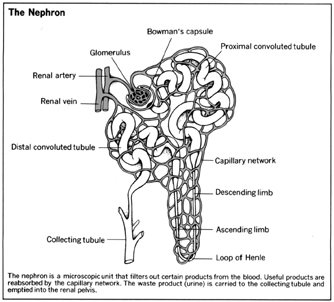The Urinogenital System and the Kidneys - The kidneys
The kidneys are located just behind our abdominal cavity on either side of the spinal cord, their tops usually tucked just under the bottommost rib. Each of our kidneys is four to five inches long and weighs about half a pound. The right kidney is normally placed a bit below the left, to accommodate the bulky liver lying also on the right side above it. Neither kidney is fixed rigidly; both can shift position slightly. Lying outside the muscular sheath of the abdominal cavity, the kidneys are more vulnerable than most internal organs to outside blows, but good protection against all but the severest jolts is afforded by surrounding fatty cushions, the big back muscles, and the bone and musculature associated with the spinal column.
As it has with the lungs, the liver, and most other vital organs, nature has supplied us with a large reserve capacity of kidney tissue—a life-giving overabundance in the event of kidney disease or injury. Indeed, normal function of only one-half of one kidney can sustain a person's life.
The kidney's task of purifying our internal environment—that is, our circulating blood—is really a double task. Each kidney must purify the blood that passes through it, sending back into circulation only “clean blood”; and it must dispose of the impurities it has taken from the blood. The latter is accomplished by the urine draining down a tube, or ureter , leading from each of the two kidneys to one common urinary bladder . Urine is discharged from the bladder down another tube called the urethra to the external opening for urination.
How the Kidneys Process Body Fluids
Blood is brought to the kidney by a renal artery, is treated in the kidney's unique microscopic structures, and exists via the renal vein. ( Renal means associated with the kidneys.) The sheer volume of blood processed by both our kidneys is prodigious: between 400 and 500 gallons are processed every day.

Internal Structure
Within each kidney are over a million microscopic units called nephrons . The nephron is the basic functional unit of the kidney—a little kidney in itself—and is really a superbly engineered and coordinated arrangement of many smaller structures, all working together.
Blood arriving at the kidney from the renal artery is quickly channeled into finer and finer vessels, until finally it flows into a kind of cat's cradle or “ball of wool” structure called a glomerulus (composed of intertwining, microscopic vessels called glomerular capillaries). The entire structure of the nephron is built around the microscopic glomerulus (Latin, “tiny ball”). Surrounding the glomerulus, like a hand lightly cupping a ball of wool, is another structure called Bowman's capsule . Fluid and dissolved materials filter out of the blood from the glomerular capillaries through the membranes into Bowman's capsule.
Substances in Bowman's Capsule
The fluids and dissolved materials filtering into Bowman's capsule are by no means all wastes and impurities. In fact, some of the substances must soon be reclaimed. Among the waste substances captured by Bowman's capsule and destined for excretion in urine are various nitrogen salts and other waste products of cellular metabolism, as well as actual or potential poisons that have entered or accumulated in the bloodstream. Non-waste substances include needed sugars and salts, and water.
Reclaiming Essential Substances
Before we leave the glomerulus altogether behind, it should be noted that like any capillary bed, this small ball of blood vessels has not only an inflow from the renal artery but also outflow vessels leading eventually back to the renal vein.
From the cupped lips of Bowman's capsule, fluid and dissolved substances from the blood trickle into a single tube called a kidney tubule . The outflow vessels from the glomerulus wind closely over and around the tubule, forming a capillary network around it. By this means the non-waste substances are reclaimed and returned to refresh the blood moving away from the nephron.

The tubule itself makes many twists and turns—including one hairpin turn so stunning that it has its own medical name— Henle's loop . So much twisting and turning gives the tubule a great deal more surface area than a simple, straight tube would have within the same space, thus increasing the amount of water and dissolved substances that can be recaptured by the encircling capillaries.
If there were no recapturing system in the kidneys, death would probably result from dehydration. Even if that could be avoided, the loss of essential salts and other substances would prove fatal in a short time.
The arithmetic of the situation goes something like this: every day, an estimated 42 gallons of fluid filter out of the glomeruli and into the two kidneys’ approximately two and a half million tubules. Dissolved in this 42 gallons—representing about three times the body's weight—are about two-and-a-half pounds of common salt, just one of the many substances in the fluid that our body needs in sufficient amounts. The loss of either water or common salt at a rapid rate would prove fatal in a matter of hours.
But so efficient is the tubule-capillary recapturing system that only an average of less than two quarts of fluid, containing just one-third ounce of salt, pass daily out of the kidneys into the ureter and are excreted as urine. In other words, over 99 percent of both the water and common salt removed from the blood at Bowman's capsules is returned to the blood.
